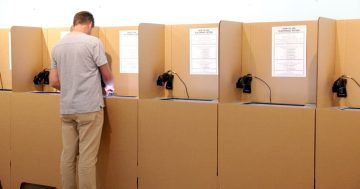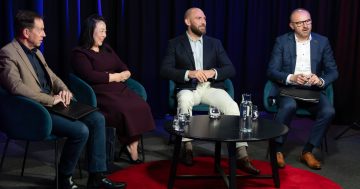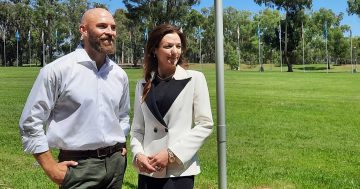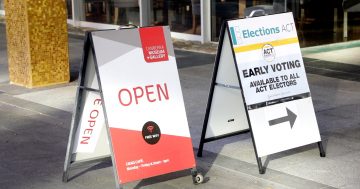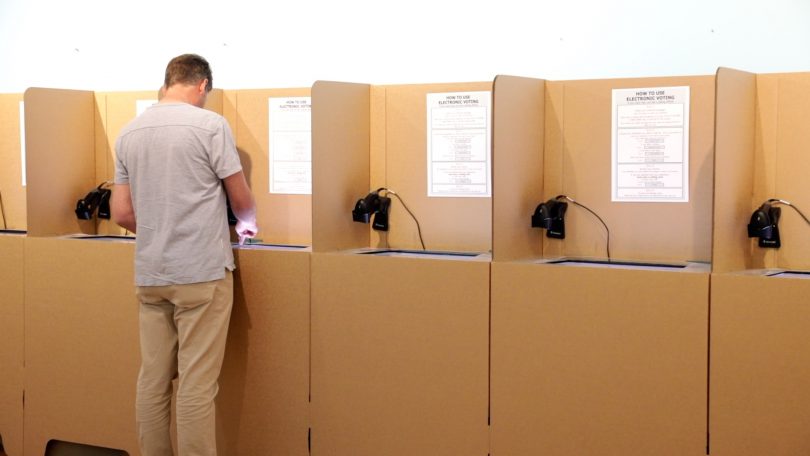
Here’s everything you need to know about Saturday’s election. Photo: Region Media.
- How do I vote?
- Where can I vote?
- What is the Hare-Clark system?
- What are the key policies?
- ACT Labor
- Canberra Liberals
- ACT Greens
- How much will all these commitments cost?
- I don’t like what I’m hearing so far, is voting for a minor party worth it?
- Will there be democracy sausages?
If you’re waiting until the very last minute to make up your mind who you’ll vote for in the ACT election, or are completely jaded by a seemingly endless campaign, we’ve compiled the most pertinent points you need to know before heading to the polling booth.
Here are the answers to your ACT election questions.
How do I vote?
Voting in the ACT is different from other jurisdictions. The ACT has a unicameral government, meaning there’s only one legislative chamber.
This means you can’t vote above the line, or for the party alone. Instead, you must number the candidates you want to vote for directly, putting a number one next to your first preference, two for your second and so on.
More than 90 per cent of pre-poll voters have voted electronically. If you choose to vote electronically, the process is the same, only you select your preferences on the screen rather than marking them on the ballot paper.
You must number at least five candidates, one for each seat available in your electorate, but votes that don’t extend to five preferences are still counted, the ACT Electoral Commission says.
Where can I vote?
As for the act of voting, there are 15 early voting stations open between 9:00 am and 5:00 pm weekdays, with extended hours until 8:00 pm Friday.
On Saturday, 17 October – election day – polls will be open from 8:00 am to 6:00 pm at 82 polling places across the ACT. You can find a full list of polling places at Elections ACT.
What is the Hare-Clark system?
Hare-Clark is a proportional representation voting system. Each candidate must currently receive 16.6 per cent of the total votes to be elected.
When a candidate receives more than the required quota, their surplus votes are redistributed according to the preferences recorded by voters.
What are the key policies?
The election has been fought on four main battlegrounds this year: health, education, the environment and a post-COVID economy.
The Liberals have been keen to point out that 19 years of incumbency has left the Government “tired and old” while Labor is running on its “experienced and progressive” record.
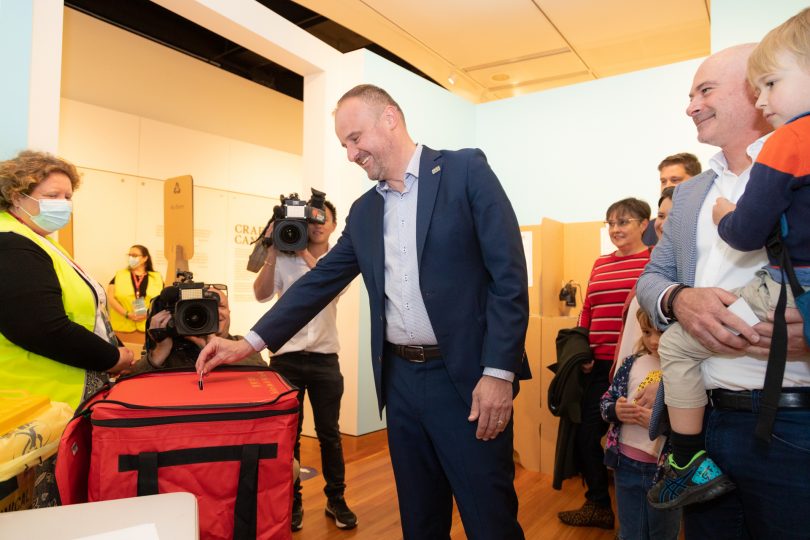
Chief Minister Andrew Barr voted with his family on the first day of pre-polling. Photo: Region Media.
ACT Labor
A year ago, Labor insiders saw incumbency as a potential weakness, focussing on how to stem the tide of voters who thought it might be time to give the other side a go. After 19 years, there was nowhere to hide or shift blame.
But after leading the ACT through the pandemic, Chief Minister Andrew Barr is now hoping voters will stick with his government rather than try untested Liberals.
Labor also hopes to entice voters with a suite of new schools and school upgrades, 400 more health staff and five new nurse-led walk-in centres across the city.
A $100 million big battery will be built to help lower electricity prices and grow the ACT’s renewable energy sector, Labor says.
Visit ACT Labor to learn more.
Canberra Liberals
The Liberals have done an excellent job of stripping back all their announcements to one key point – making Canberra more affordable. This underpins their biggest policies, including the signature pledge to freeze rate rises for the next four years.
The Liberals have also promised to increase bulk-billing, cut car regos and halve emergency department waiting times.
Elective surgeries will increase over the next four years under a $125 million package. There’s also the pledge to plant one million trees across the ACT by 2030, but the full cost of the policy has not been released.
Visit the Canberra Liberals to learn more.

Could Opposition Leader Alistair Coe be the first Liberal Chief Minister in nearly two decades? Photo: file.
ACT Greens
The Greens have gone hard to make this election a referendum on climate change, bringing the target for a fossil fuel and gas-free ACT forward by five years, and ceasing new gas connections in the next few years.
The party has pledged $450 million for its premier social housing package, and $60 million for an electric vehicle package including subsidies for electric cars and more recharging stations.
Money to clean up Canberra’s waterways, ambitious ‘Closing the Gap’ targets to reduce Indigenous overrepresentation in the justice system and more support for people experiencing mental health problems, including drug and alcohol abuse have also been promised.
Visit The Greens to learn more.
How much will all these commitments cost?
Depends on who you ask.
Labor has promised to spend an extra $550 million above what’s already allocated in the budget up until the 2024-25 financial year. The Liberals say the total cost of Labor’s policy comes to $1.5 billion, and $1 billion for the Greens.
The Liberals put the cost of their election commitments at $1.1 billion, but Labor’s estimates were also higher, putting the Liberals total spend at $1.4 billion.
However, in contrast to Labor, the Liberals say all of their policies will come from money already in the budget, promising not to borrow another cent while cutting taxes and improving services across the ACT. This will be done by growing the “economic pie”, enticing more people from NSW to live in Canberra, opening businesses and paying taxes here.
It is a theory that has drawn constantly criticism from Labor, which says an extra 100,000 ratepayers will need to move to the ACT next year to make enough money through rates and taxes to pay for the Liberals promises.
The Greens have not released a total cost for their commitments. All three parties have submitted the majority of their policies to the ACT Treasury to be independently costed, although many are still in progress, having only been submitted in the final week.
I don’t like what I’m hearing so far, is voting for a minor party worth it?
That’s up to you.
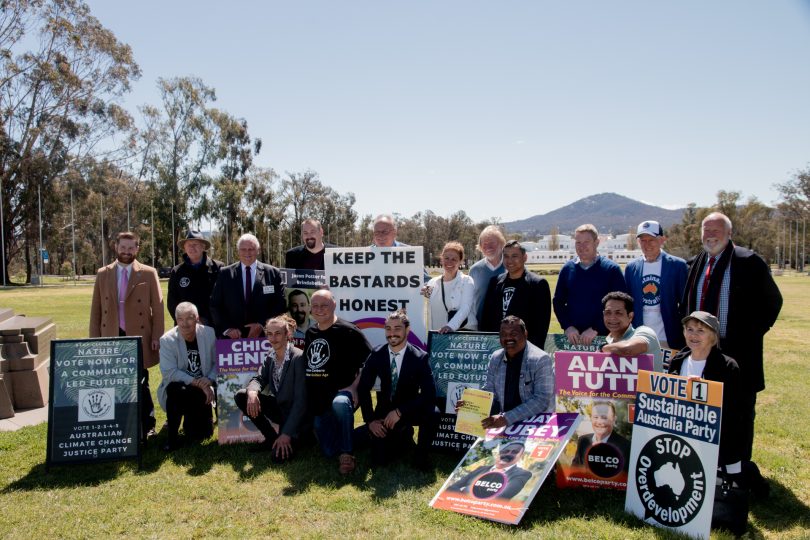
Minor parties in the ACT have banded together to promise free solar panels and batteries for all Canberrans. Photo: Dominic Giannini.
Outside the Greens, no minor party or independent has won a seat in the ACT Assembly since the 2001 election.
In part, this is due to Hare-Clark and the flow of preferences. But remember, you don’t have to number all of the candidates. If you wish to vote for a minor party or independent, you can choose whether your preferences later flow to a different party.
Independents will be listed in the box on the far right of your ballot paper.
Just be careful when voting, some parties have similar names (like Labor and Labour DLP).
Be sure to check out the policies of the party or person you choose to vote for. A list of candidates for your electorate can be found at Elections ACT. You can also find many candidate statements at the Canberra Alliance for Participatory Democracy site.
Will there be democracy sausages?
Thankfully, yes!












